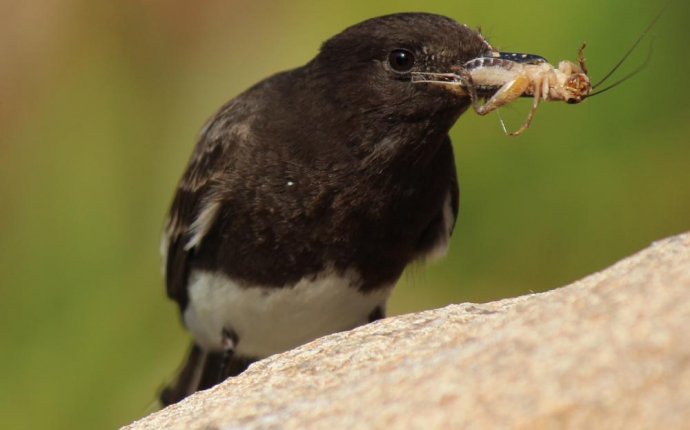
Black Phoebe, Sounds
 The Black Phoebe is a medium-size sized flycatcher (6.5”) and the only black flycatcher in North America. The upper back, breast, and head are a sooty black, while the lower back, wings, and tail are brownish slate. The belly is entirely white, along with the undertail feathers.
The Black Phoebe is a medium-size sized flycatcher (6.5”) and the only black flycatcher in North America. The upper back, breast, and head are a sooty black, while the lower back, wings, and tail are brownish slate. The belly is entirely white, along with the undertail feathers.
Food Habits
The Black Phoebe visually locates prey (flies, bees, beetles, butterflies, grasshoppers, etc.) from a low perch or by hovering, and pursues it until capture. Typically, only one prey item is captured on each flight, which take place in open areas. Small prey is eaten in flight and larger prey is taken to a perch where it is beaten then swallowed whole. The Black Phoebe, like other flycatchers, has ligaments connecting the upper and lower jaws that act as springs to snap the gaped jaw shut when an insect is snared.
Nesting
Black Phoebes rarely use natural structures for nesting. They prefer buildings, bridges and culverts, where they build a nest cemented with mud to a vertical wall of the site. The top of the nest is most often close to a protective ceiling. Common to all nest sites are:- a ceiling that protects the nest from weather and provides concealment,
- placement near or directly over water,
- placement close to a source of mud for construction material,
- an area surrounding site suitable for foraging.
 Behaviors
Behaviors
Black Phoebes accomplish most locomotion via flight which is direct with steady wing-beats. They rarely move on the ground, but occasionally land on the ground near potential prey and hop several centimeters to capture the prey item. Both sexes preen frequently throughout the day, often during or between foraging bouts, or after leaving the nest during incubation.
Territories are aggressively defended using vocalizations and chase. During incubation, males will perch near nests throughout the day. As a species, they are nonsocial except in association with mate their during breeding season. Pair bonds are not maintained after breeding season.
References
The Birds of North America No 268, 1997; Wolf, Blair O.









